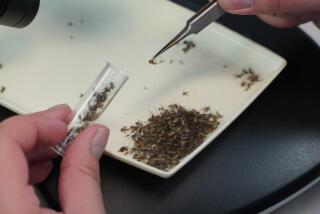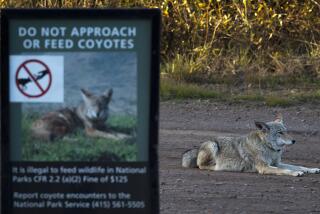A Plethora of Snakes Brings Plenty of Bites
- Share via
ORANGE — Snakebites are up, indicating that the number of rattlesnakes could be on the rise in Southern California.
A recent upsurge in rattlesnake bites treated in Orange County reflects a growing reptile population, according to several outdoor experts and park authorities. One park official said winter rains have produced more vegetation, creating a better environment in which snakes can thrive.
At UCI Medical Center here, five people have been treated for rattlesnake bites in the past four weeks. None of the bites were fatal, but a medical official said the number is surprising.
“It’s unusual to have so many snakebites this early in the season,” said Dr. Kym Salness, director of the emergency department at the medical center.
In another unusual incident, a horse at Orange County’s O’Neill Regional Park died April 26 within a half hour after being bitten by a rattlesnake. The horse was repeatedly bitten on the leg by “a very aggressive rattlesnake,” according to one park ranger.
UCI Medical Center’s most recent snakebite victim was a 36-year-old man who was treated Sunday after being bitten by a rattler in Garden Grove. Salness, who is the snakebite expert for the UCI Poison Control Center, said the victim was startled to find the reptile in an urban environment such as Garden Grove.
All the other snakebite incidents occurred in fields or parks where snakes are more common, Salness said.
Tim Miller, director of Orange County’s regional parks, said he has no clear-cut data on a possible increase in rattlesnakes. He said, however, he could make an educated guess as to why snakes may be more prevalent this year.
“With rainfall, everything is now growing,” Miller said. “Rains have improved the growth that supports rodents, and an increase of rodents would allow for an increase of snakes.”
Miller said the April 26 death of the privately owned riding horse at O’Neill Regional Park was unusual because horses seldom die from snakebites.
Ron Slimm, a ranger at O’Neill Regional Park, said Monday that he had talked to the woman who was riding the horse when it was bitten.
“The snake was aggressive,” Slimm said. “This woman was out riding in the park when the snake attacked the horse. The horse died within 30 minutes.”
Slimm said he could not say for sure that the number of snakes has increased this year. But he added: “It would stand to reason (that there is an increase) because the rain has increased the vegetation and rodent population.”
Rangers at other parks in Orange County had mixed reports. Some said they suspected a snake increase, but others said they doubted if reptiles were more numerous this year.
Park Ranger Raymond Osuna at Irvine Regional Park said: “I haven’t seen an increase. I’ve seen rattlesnakes every weekend for the past month, but no more than usual.”
By contrast, Park Ranger Jude Weierman at the Aliso and Wood Canyons Regional Park in south Orange County said he was certain that rattlesnakes are growing in number this year.
“I personally have seen more rattlesnakes this year than in the past few years,” Weierman said. “I’ve seen about a dozen so far this year, and normally I’d only be seeing about four or five by this time of year.”
Marie Hulett-Curtner, spokeswoman for Orange County’s Animal Control Department, said the agency gets about 12 rattlesnake calls a day from people all over the county. “Most of the calls come from the foothill areas, but rattlesnakes are sometimes found in the cities, too,” she said. “We found one about six months ago in an elementary school in Fountain Valley.”
Hulett-Curtner said the number of calls about rattlesnakes is not unusually high this year. But she said not everyone telephones authorities after spotting a rattlesnake. She believes that it is likely the snake population has increased.
“It’s a matter of the food chain,” Hulett-Curtner said, referring to the increased rain making more vegetation possible. “As the food chain goes up, so does the reptile and animal population.”
Salness, the UCI Medical Center expert on snakebites, said reptiles, including rattlers, usually shy away from humans. He said that in the vast majority of human snakebite cases, people have deliberately put themselves into danger by trying to capture or handle poisonous reptiles.
“The most frequent type of victim is a young male in his 20s who has been intentionally interacting with a snake,” Salness said.
Exact details were not immediately available on the five recent snakebite cases treated at the medical center. But Salness said two of the cases did not fit the normal pattern.
“In one of these incidents, a little girl in the Corona area was truly innocent,” Salness said. “The child, who was about 7 or 8, went over to look at a snake, and it bit her on the ankle.”
Salness said another unusual incident among the five recent snakebites involved a jogger in Anaheim Hills. “This jogger was out running, and he said he tripped and fell over a rattlesnake,” Salness said. “The snake bit him on the hand.”
Rattlesnake bites are rarely fatal but need to be treated, Salness said.
The doctor said that despite the unusual number of snakebites this year, he doubts that there has been any significant increase in the rattlesnake population.
“I don’t really think we’re having an epidemic,” he said. Salness also said that people, in almost all cases, can avoid snakebites by using simple caution.
“Snakes usually get a bad rap,” Salness said. “Snakes are usually just minding their own business.”
It’s Rattlesnake Season: Beware
AVOIDING SNAKEBITES * If you encounter a snake, slowly back up. Make no sudden moves. Avoid contact. Do not try to chase or capture it. * Keep your eyes on the ground ahead of you when hiking in wild areas. Carry a walking stick, wear thick pants, high socks and high-top boots. * Do not put your hands or feet into areas you can’t see, such as under rocks, on overhead ledges or in brush.
IF YOU ARE BITTEN * Do not try to capture or kill the snake. * Keep calm and still in order to prevent spreading the venom. Do not drink any alcoholic beverage. * Tie a snug, but not tight, tourniquet on the bitten arm or leg. The band should not be so tight as to stop blood circulation. Loosen the band as the area swells. * Do not attempt to lance the bite and suction out the venom unless you are many hours from medical help. * Get to a hospital as quickly as possible. * If you are with someone who is bitten, carry the person to help if possible. Sources: U.S. Department of Forestry, UC Irvine Poison Control Center
More to Read
Sign up for Essential California
The most important California stories and recommendations in your inbox every morning.
You may occasionally receive promotional content from the Los Angeles Times.













